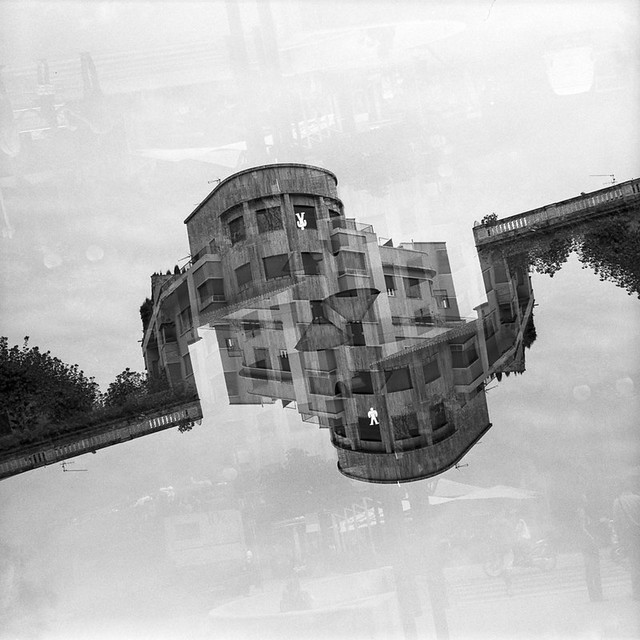I like this by the way the sky and snow it mixes together.
This was taken five minutes later from the blue one
I thought of the composition trying to get the bus in it as well.
Wednesday, 6 February 2013
Friday, 1 February 2013
Harry Callahan
 I like this because of the fact it looks like he took the picture because it just looks like a reflection the composition of this picture is amazing.
I like this because of the fact it looks like he took the picture because it just looks like a reflection the composition of this picture is amazing.Harry Callahan was born in detroit in 1912, a photographer who became famous during the 20th century for his unconventional perspective on everyday scenes and objects. During his career he headed the photography departments at the Chicago Institute of Design and the Rhode Island School of Design. He received the National Medal of Arts in 1997 for his work.
Henri Cartier Bresson
I like this because its a black and white but its amazing by the fact of the guy being in the air.
Regarded as one of the greatest photographers of his time, Henri Cartier-Bresson was a shy Frenchman who elevated "snap shooting" to the level of a refined and disciplined art. His sharp-shooter’s ability to catch "the decisive moment," his precise eye for design, his self-effacing methods of work, and his literate comments about the theory and practice of photography made him a legendary figure among contemporary photojournalists.
His work and his approach have exercised a profound and far-reaching influence. His pictures and picture essays have been published in most of the world’s major magazines during three decades, and Cartier-Bresson prints have hung in the leading art museums of the United States and Europe (his monumental ‘The Decisive Moment’ show being the first photographic exhibit ever to be displayed in the halls of the Louvre). In the practical world of picture marketing, Cartier-Bresson left his imprint as well: he was one of the founders and a former president of Magnum, a cooperative picture agency of New York and Paris.
Henri Cartier-Bresson was born in 1908, in Chanteloupe, France, of prosperous middle-class parents. He owned a Box Brownie as a boy, using it for taking holiday snapshots, and later experimented with a 3 X 4 view camera. But he was also interested in painting and studied for two years in a Paris studio. This early training in art helped develop the subtle and sensitive eye for composition, which was one of his greatest assets as a photographer.
 In 1931, at the age of 22, Cartier-Bresson spent a year as a hunter in the West African bush. Catching a case of backwater fever, he returned to France to convalesce. It was at this time, in Marseille, that he first truly discovered photography. He obtained a Leica and began snapping a few pictures with it. It was a pivotal experience. A new world, a new kind of seeing, spontaneous and unpredictable, opened up to him through the narrow rectangle of the 35 mm viewfinder. His imagination caught fire. He recalls how he excitedly "prowled the streets all day, feeling very strung-up and ready to pounce, determined to ‘trap’ life, to preserve life in the act of living."
In 1931, at the age of 22, Cartier-Bresson spent a year as a hunter in the West African bush. Catching a case of backwater fever, he returned to France to convalesce. It was at this time, in Marseille, that he first truly discovered photography. He obtained a Leica and began snapping a few pictures with it. It was a pivotal experience. A new world, a new kind of seeing, spontaneous and unpredictable, opened up to him through the narrow rectangle of the 35 mm viewfinder. His imagination caught fire. He recalls how he excitedly "prowled the streets all day, feeling very strung-up and ready to pounce, determined to ‘trap’ life, to preserve life in the act of living."Thus began one of the most fruitful collaborations between man and machine in the history of photography. He remained devoted to the 35 mm camera throughout his career. The speed, mobility, the large number of exposures per loading, and, above all, the unobtrusiveness of the little camera perfectly fitted his shy, quicksilver personality. Before long he was handling its controls as automatically as an expert racing driver shifts gears. The camera itself, in his own famous phrase, became an "extension of the eye".
John Virtue
 John Virtue was born in accrington and attended the slate school of art, he won the art council major award. His medium theirs not a lot of contrast in his monotone work.
John Virtue was born in accrington and attended the slate school of art, he won the art council major award. His medium theirs not a lot of contrast in his monotone work.He work solely a black and white printer which he work's on large canvases, the materials what John uses is white, acrylic, black ink and shellac, what properly seals it to the canvas.
His influences was Dutch and Flemish painters who are Ruisdael, Koninckx and Rubens. His style is in the American abstract expressionist artist and Oriental brush art.
Subscribe to:
Comments (Atom)







